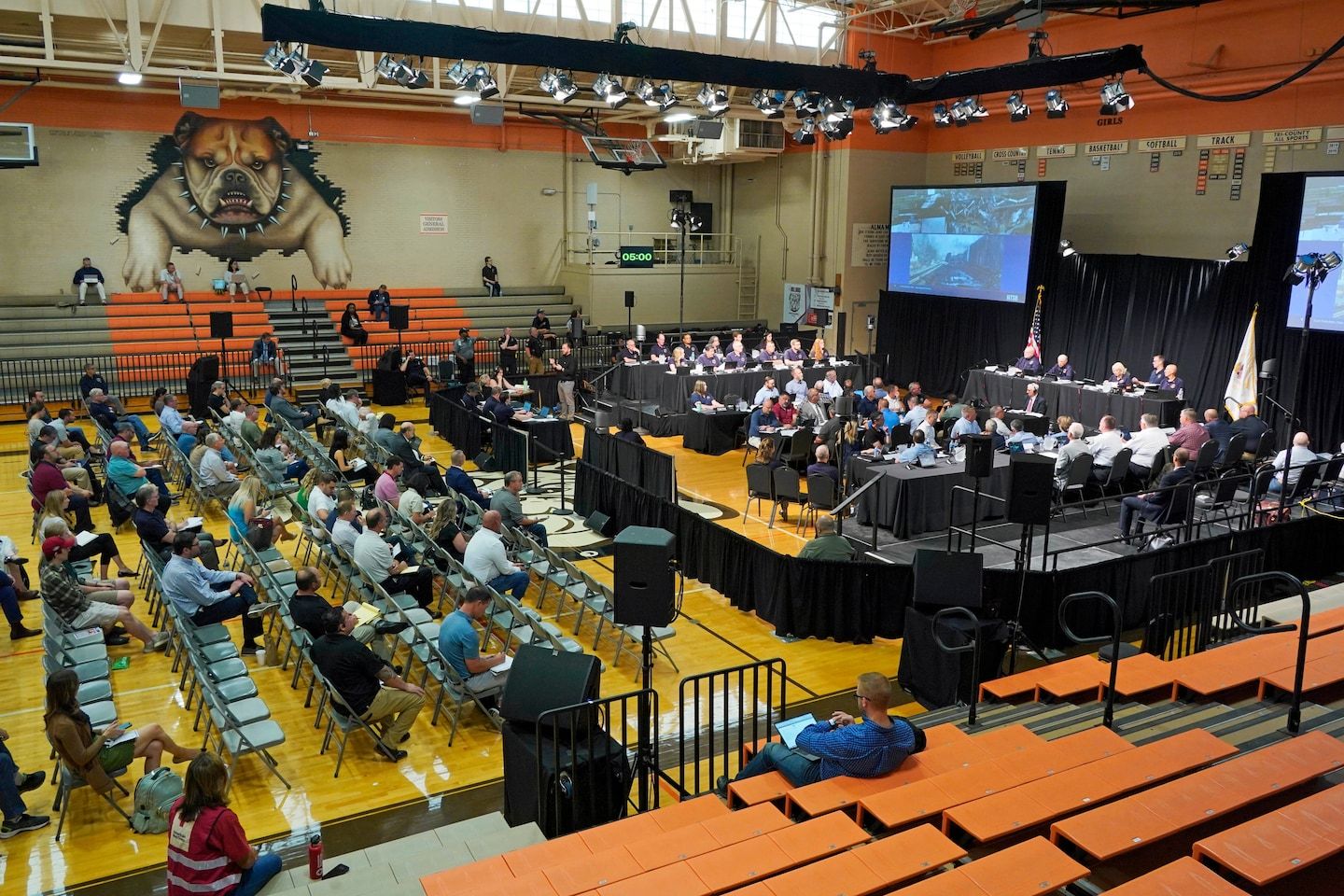East Palestine fire chief to NTSB hearing: 13 minutes to make key decision
Listen 9 min Comment on this story Comment Gift Article Share
EAST PALESTINE, Ohio — The East Palestine fire chief told investigators probing a Norfolk Southern derailment that the railroad gave him 13 minutes to decide whether to vent and burn carloads of hazardous vinyl chloride — a timeline he said left him feeling “blindsided.” Wp Get the full experience. Choose your plan ArrowRight The decision would change a serious derailment in early February into a national event that became the backdrop for weeks of culture war battles, generating apocalyptic images of thick black smoke spewing over the small Ohio community.
Fire Chief Keith Drabick said he was pulled from a meeting three days after the derailment to see Norfolk Southern chief executive Alan Shaw and contractors managing the response. Drabick was told they urgently wanted to get to work before the sun set.
“I was very overwhelmed by that approach,” Drabick told investigators, according to a transcript released Thursday.
Advertisement
Drabick’s new account was released as the National Transportation Safety Board began two days of hearings in East Palestine, questioning witnesses and sharing almost 5,000 pages of records. The hearings — the first of their kind since 2017 — and documents provide the most detailed account yet of the derailment and emergency response, including witness transcripts and testimony revealing deep confusion that persisted in the days after the incident.
Dozens of East Palestine residents gathered in the village’s high school gymnasium to listen to experts and railroad officials describe how they arrived at the decision to vent and burn the five vinyl chloride tank cars. Some said they were troubled by revelations that the derailed tank car that most worried emergency responders was cooling slightly before it was vented and burned, amid conclusions by some experts that the controlled release could have been avoided.
The derailment was caused by an overheating wheel bearing on one of the train’s 149 cars. Dozens of cars came off the tracks — including 11 that were carrying hazardous chemicals, starting a fire. Nearby residents were evacuated and still have questions about the effects on their health.
The emergency response faced trouble almost immediately, according to the records and testimony. NTSB Chairwoman Jennifer Homendy questioned Norfolk Southern about why it took several hours to turn over records to firefighters of what was on the train. Faulty modeling misled the governor of Ohio about the risks of venting and burning the vinyl chloride. And new accounts from experts at chemical company Oxy Vinyls, which was shipping the vinyl chloride, call into question the decision to vent the gas.
The company was not directly involved in the plan to vent tank cars carrying the chemical. But executives briefed Norfolk Southern’s hazmat contractor, Specialized Professional Services, over the weekend after the Friday night derailment while saying that despite the fear of crews on the ground, it did not think a dangerous reaction — known as polymerization — was taking place inside the tanks.
Advertisement
“If a vent and burn is being considered, it should not be done because of polymerization, because polymerization is not occurring,” an Oxy Vinyls executive said on a call the day before the final decision was made, according to an NTSB summary released Thursday.
Drabick told investigators, according to the summary, he did not receive input from Oxy Vinyls or hear any opinion contradicting the fear of polymerization.
Homendy said Thursday more information should have been shared: “Norfolk Southern had the conversations with Oxy Vinyls, and if nobody knows the conversations were had, that information needs to be provided.”
Specialized Professional Services then worked with other contractors to burn the tanks, a procedure that involves using explosives to blow small holes in their sides.
Crews had been monitoring elevated temperature in one of the tanks, fearing it could suffer a catastrophic explosion if it got too hot. The temperature inside the tank appeared to be decreasing before the vent and burn was carried out, but witnesses defended their actions at the hearing Thursday, saying data did not necessarily mean risks were subsiding.
Advertisement
“All data, resources and all of our combined experiences had us with a legitimate concern for polymerization,” said Drew McCarty, president of Specialized Professional Services.
The on-scene hearing is the first since the NTSB sent representatives to Alaska as part of a plane crash investigation six years ago and is a rare chance for the public to observe the NTSB’s investigators at work. It marks a milestone in the East Palestine investigation, which is likely to continue into 2024, at which point the board will formally determine the cause of the derailment and issue safety recommendations for how such incidents can be avoided.
A community town hall Wednesday evening was an opportunity for residents to share their frustrations about the derailment and its aftermath. Some said too many questions remain about the incident, the chemicals that spilled and the effects on their town, while others urged more accountability for the rail industry and federal regulators.
Advertisement
“It’s frustrating,” said Laurie Harmon, a resident who lives near the tracks.
Homendy told residents she would continue advocating for the community, pushing lawmakers to adopt any safety recommendations the board issues.
“This isn’t just a paperwork exercise,” she said. “We fight really hard.”
Norfolk Southern has said it will support East Palestine for the long term, pledging $62 million in financial assistance.
While the company has faced criticism for its handling of the derailment, Shaw told NTSB investigators that view will change years from now.
“What we’re going to do is we’re going to respond in a way so that five years from now, 10 years from now, we can look back on this and the citizens of East Palestine can look back on this and we can both be proud of Norfolk Southern’s response,” he said. “That’s my focus and that’s how I’m running the railroad.”
In an interview two days after the derailment, the train’s engineer, Tony Faison, recalled that his leg of the journey started as a “nice, normal trip.” At the same time, there were possible signs of trouble brewing, according to the records.
The derailed train, designated Train 32, was making a multiday journey across the Midwest. Earlier in the trip, it experienced mechanical problems, including a brake pipe and air issue the day before the derailment, as well as a broken part on a coupler.
Video that investigators obtained from Rootstown, Ohio, about 45 miles from East Palestine, captured the train making a loud screeching sound. After it passed through the Ohio towns of Sebring — about 38 miles from the derailment site — and Salem, about 26 miles west of East Palestine, the glow of flames appeared beneath the lead axle on the south side of the tracks, said lead NTSB investigator Ruben Payan.
A detector along the side of the track that is designed to catch overheating bearings before they cause a derailment measured an elevated temperature and sent an alert to a Norfolk Southern safety desk in Atlanta. The alert was not considered critical and didn’t require the safety desk or crew to take action.
Advertisement
The next detector was in East Palestine. Faison, a train engineer since 1999, said the situation changed rapidly.
“As soon as I went over the detector … within seconds, it said ‘critical alarm, critical alarm,’” he told investigators.
Conductor Kevin Stauffer told investigators only seconds passed between when the critical alarm went off and when the train crew declared an emergency. Outside the train, Stauffer said he could see smoke rolling as he climbed over the locomotive.
“There’s an instinct when you see a fire,” he said. “You know [it was] a big fire back there, and I was like, ‘Yeah, we’ve got to get out of here.’”
Drabick, the East Palestine fire chief, was on his way out of town and raced back. Drabick’s deputy took control of the scene, later describing the initial blaze to investigators as “much larger than I personally have ever seen.”
Advertisement
A video released Thursday that shows firefighters approaching a blazing railroad tanker was the subject of pointed NTSB questioning on safety guidelines.
Video provided by the National Transportation Safety Board shows firefighters approach the East Palestine, Ohio, train crash site. (Video: NTSB)
Firefighters can be seen carrying a hose through a doorway, with raging flames just outside. NTSB member Michael Graham suggested the firefighters’ actions appear to be in conflict with a firefighting safety manual.
“It states, and in capital letters, says, ‘Always stay away from tanks engulfed in fire,’” Graham said. “Was the emergency response guide referenced prior to sending firefighters in?”
William Jones, chief of the fire department in nearby East Liverpool, Ohio, and Drabick said they could not say, because they did not know precisely where or when the video was taken.
McCarty, the contractor brought in by Norfolk Southern, credited firefighters’ initial actions with saving surrounding buildings, but said local crews are often unprepared to face a hazardous derailment. He told investigators he urged firefighters to back up.
Advertisement
“You’re committed too close,” he recalled saying. “You’re not going to put these fires out. There’s things that are going to go on here. We don’t know what yet. But we need to pull you back.”
Through the night, darkness prevented responders from determining exactly where the biggest problem was, but attention became focused on the cars carrying vinyl chloride.
The Monday after the derailment, as McCarty and his team homed in on the plan to vent and burn the cars, he said he was asked to brief Ohio Gov. Mike DeWine (R), a situation he described as a “political hornet’s nest.”
McCarty recalled that with Pennsylvania Gov. Josh Shapiro (D) joining on speakerphone, DeWine asked, “How can you guys kill 3,000 people over 14 miles?”
Modeling that the governor had reviewed was based on faulty data about the risks, McCarty said, adding that he was able to help revise the estimates. But the delay cost time, with dusk approaching.
Drabick said he asked the team to go over the implications of the vent and burn operation one last time before he made the final call.
“This is a very large decision that can affect my community and my men, and I needed that explained once again,” Drabick recalled saying.
He consulted with several of his officers and approved the plan.
Duncan, Dance and Aratani reported from Washington.
Gift this article Gift Article
Source: The Washington Post


